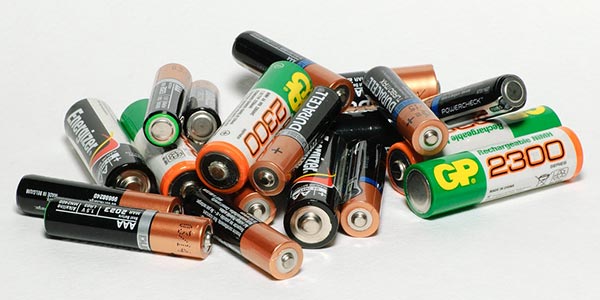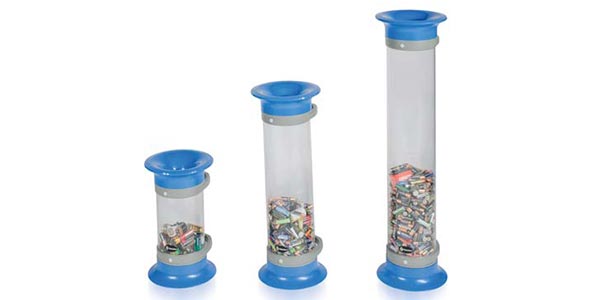In the U.S, we purchase an estimate of 3 billion dry-cell batteries every year - enough to fill 8 White Houses', or cover the entire length of the Grand Canyon (277 miles) not once or twice, but almost three times!

With recent research suggesting that the Dry Cell Battery Market is expected to witness significant growth in the coming years, primarily driven by the growing demand, this figure is bound to increase, so what can we do about it?
When possible, we should endeavour to buy reusable batteries or diligently recycle our batteries in appropriate battery recycling containers - this would not only protect the environment from harmful and toxic waste, but also drive job creation and the production/innovation of new products.
But unfortunately, this isn’t always the case, which means we aren't fully reaping the potential benefits of battery recycling - a massive opportunity, missed.
Why is this a big deal?
The improper disposal of these batteries poses a severe threat not only to our environment, but our health as well. Here’s how;
- Pollution Risks: Improper disposal of batteries in household waste can lead to water and air pollution, releasing toxic elements that pose a threat to groundwater and air quality. This has significant implications for both environmental health and human well-being.
- Fire Hazard: Tossing batteries into general trash increases the risk of fires, for instance, discarded lithium-ion batteries accounting for 65% of waste facility fires in California in 2017. Addressing this fire hazard is crucial for preventing environmental damage and ensuring public safety.
- Global Consequences: The collective mismanagement of batteries contributes to a global environmental impact, affecting ecosystems, biodiversity, and the overall health of the planet. Implementing responsible disposal practices is essential to mitigate these consequences and promote a sustainable future.
Issues like the above can easily be avoided with a simple waste management strategy. Here’s how you can make a difference:
Make it easy and convenient:
Ensuring that battery recycling containers are easily accessible is crucial to encouraging higher usage rates. In today’s world, where convenience is key, the accessibility factor plays a pivotal role in the success of recycling initiatives.
Place Bins in common areas:
Keep recycling bins where people naturally gather – staff canteens, shared offices, or by the entrance/exit doors at stores. That way, you'll get people to recycle without messing up their daily flow. It's all about making recycling fit into their lives without causing a fuss.
Recycle right:
Most single-use batteries (AA, AAA, C, D) used in homes and businesses are recyclable. However, Nickel-cadmium rechargeable batteries are hazardous waste and MUST be recycled. Non-hazardous batteries like Lithium Ion and Nickel Metal Hydride are also recyclable, including button cell batteries in products like watches and hearing aids, containing materials like silver and mercury. Use Earth911's search tool to find a reputable local battery recycling vendor.
Make it Yours:
Personalization goes a long way in making those bins impossible to miss. Customize those bins with details about what batteries to throw in, some recycling goals, or even a friendly reminder to recycle.
Glasdon C-Thru™ Battery Recycling Containers:
Our battery recycling containers offer a transparent solution that not only showcases a sleek design but also emphasizes quality and durability. With a robust build you can see and touch, these containers exude reliability, designed to withstand the rigors of everyday use without sacrificing their form or function.
At Glasdon, we provide a range of personalization options which can further assist users in knowing exactly what can be placed in your battery recycling containers, as well as other information such as; fund-raising targets, measuring levels, or other design graphics you may wish to include.

Our C-Thru 5Q, 10Q and 15Q are ideal recycling containers when collecting domestic batteries, and have proved to be a popular choice in a range of environments, including office spaces, education, retail, and grocery stores.
Here's what else they have to offer:
Each model features a funnel top lid with narrow funnel aperture which accepts small waste deposits (e.g. domestic batteries), whilst mitigating the risk of unwanted waste being deposited
Top and bottom handles provide easy handling to pick up and empty the unit
Available in a range of sizes, to best the suit the needs of your specific requirements
Range of further options also available, including; full level indicator, optional recycling decals and easy to understand instructions, as well as an open top aperture if you wish to collect alternate waste streams
Ready to improve your battery recycling? Order now via our Express and get your delivery shipped within 48 hours.
| View Express Products |
Sources:
https://www.linkedin.com/pulse/dry-cell-battery-market-growth-trends-forecast/
*https://www.icsid.org/uncategorized/how-much-money-do-americans-spend-on-batteries-each-year/
**https://sciencing.com/environmental-problems-batteries-cause-7584347.html
***https://arstechnica.com/gadgets/2022/12/recycling-firm-fined-after-tossed-batteries-cause-garbage-truck-fire




